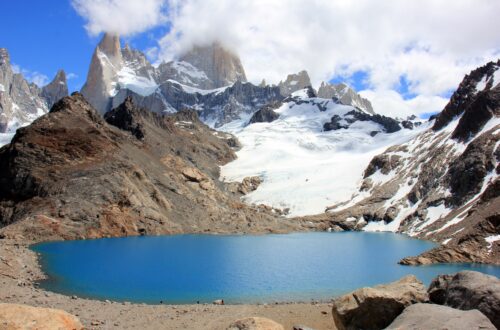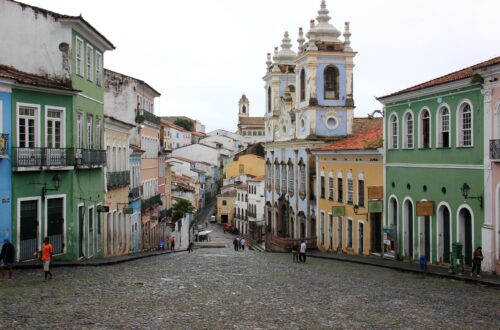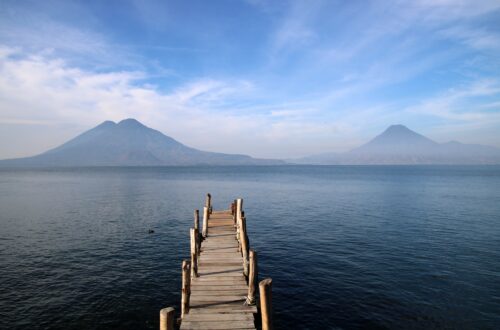Cuba
Itinerary: Havana – Pinar del Río – Vignales – Santa Clara – Hanabanilla – Trinidad – Camagüey – Sancti Spiritus – Bayamo – Santiago de Cuba – Baracoa – Holguín
Havana
On an April evening at 6:30 p.m. local time, I arrive at José Martí airport near Havana, Cuba. Passing through customs is quite slow. The lady in uniform of the Ministério del Intérior looks at me inquiringly and compares what she sees with the photo in my passport. Fortunately, I am allowed to enter the country.
In the bus on our way to our hotel in the centre of Havana I see the things you know from the pictures of Cuba: Old cars from the 1960s, socialist slogans on the walls, and old, poorly maintained buildings. A somewhat strange mixture of Spanish colonial influences and Eastern Bloc-like conditions.
After arrival at the hotel we decide to have a drink in the city. Our bio-clock is at 3 a.m., but here it’s still early and it’s a sultry evening. We end up on the terrace on the Plaza de Armas, with live music, which gets the holiday vibe going. As we walk back, we pass El Floridita, one of the most famous cafes in Havana, especially because the writer Ernest Hemmingway used to come here. It is also the place where the best daiquiris are said to be served. It’s midnight when we return to our hotel.
Next morning we do a city tour. The first stop is the large cemetery Cementerio de Colón and next we arive at the Plaza de Revolución. A place that you only know from pictures and television and where you feel the history. Here
Fidel Castro always delivers his hour-long thunderous speeches in front of tens of thousands of Cubans. I’m face to face with the famous wall of the Ministerio del Interior with the Cuban flag and the huge portrait of Che Guevara. A very impressive moment to realize I’m actually at the Plaza de Revolución in Cuba.
Next we visit the rum museum, which is basically a tourist attraction by the Cuban rum brand Havana Club. The short tour shows how rum is made. The rum tasting isn’t really for me because I don’t drink hard liquor unless it’s in a cocktail. After the museum we walk around Havana Veija (old Havana), down the old, picturesque streets and along Plaza de San Francisco and Plaza de Armas.
After lunch we walk over to the Capitolio (an exact copy of the Capitol building in Washington DC) and the Gran Teatro. After that, I walk to the Malecon, along the harbor and across a tourist market to Plaza de la Catedral. Along the way I stop at the well-known bar El Bodeguita, also a Hemmingway spot and the place where they serve the best mojitos. In addition to the old cars I also come across some old Dutch buses, still featuring the Dutch phone number of public transport information and the Dutch license plates. Very funny.
On the street I get appproached all the time. To the local Cubans, we, western tourists, are walking money trees. Almost everyone wants to earn money from you: selling cigars, exchanging money, offering a taxi ride, you name it. Of course we are their amigo or friend and we are asked where we come from. After a while I start to get quite annoyed by it, I get accosted just a little too often.
Las Terrazas, Pinar del Río, Vignales
A highway, the Carretera Central, runs from the Cuban capital Havana to the province of Pinar del Río, the region west of Havana. The highway is rarely used. There are some cars on th eroad, but you also come across cyclists and horse-drawn carriages. Everywhere are large billboards along the road and communist slogans are painted on the bridges above the road. Many people are waiting along the road in the hope that they will get a lift. They often stand there waiting for hours before being picked up.
Our first stop is a cigar factory. A small, inconspicuous building in a small village. Unfortunately we are not allowed to take pictures here. When I ask our guide, José, why not, the answer is: “Just because”. Two years ago the government banned it and nobody aquires about the reason, it’s as simple as that. Such a shame, because it’s nice to see how cigars are made. In Cuba five million copies a year and everything by hand. While we are being shown around, staff are staring at us. They want to sell us cigars (out of sight of the boss who shows us around). This is an interesting extra income for them. I buy a box of Monte Cristo cigars illegally and as inconspicuously as possible. When we leave the cigar factory, even Grandma sitting on the porch across the street is selling cigars illegally.
Next we drive to Las Terrazas, a small village that was completely set up according to socialist ideals and financed with Soviet money. The commune was built in the 1960s as an employment project for this poor region. The people here work in the coffee plantations that are also run by the state. We also visit an old coffee plantation, where the slaves used to grind the sun-dried coffee beans in the traditional way.
After lunch we drive to the San Juan River. Many Cubans from the area apparently spend theuir Saturday here, because it’s quite busy. The road leads us further into the province of Pinar del Río. The landscape is quite flat, much agricultural area. Here and there are a kind of thatched or wooden sheds in the fields where tobacco plants stood until they were harvested (which is done in February/March). The tobacco leaves are drying inside the characteristic barns. As we drive towards Vignales, the landscape changes. We drive into the mountains of the Sierra de los Organos. We stop briefly at the hotel Jazmines viewpoint, where you have a beautiful view of the characteristic, rounded mountains, which are called mogotes.
The next morning we walk from our hotel to the Cueva del Indio. With a boat we make a (short) trip in the cave. Next we go for a long walk down the beautiful valley of Vignales. There are beautiful view of the mogotes and we walk right through the tobacco plantations (where at the moment not much tobacco is growing). It’s a strange idea: Everything in Cuba is owned by the state. The land and houses are on ‘loan’ to the farmers, the proceeds flow back directly into the state treasury, the harvest goes to state processing plants, restaurants are state-owned and the guides work for the Cuban government. It is undoubtedly one of the causes of the fact that Cuba is poor, entrepreneurial spirit and commercial thinking are not encouraged.
The beautiful walk takes about 3.5 hours. On the way we visit a Cuban family who lives in the area. This farmer manages plots of land and grows tobacco and coffee. You can’t get any fresher than the coffee we are offered. Like most Cubans, the house is furnished in an extremely sober manner. A couple of chairs and a television and of course the signature rocking chairs on the porch. We also take a look in the shed where the tobacco leaves hang to dry.
In the evening we eat at people’s homes in a so-called paladare. These are locally known addresses where you can eat as a tourist. In this case it happens in a small room in an equally small house, somewhere in Vignales (meaning you have the feeling of being in the middle of nowhere). It’s very illegal and people get a hefty fine if they are caught serving to tourists. But it’s their way to earn some extra money. The food is typical Cuban: rice with black beans, tomato, cucumber, white cabbage and chicken. Food I’ve been served for three days. The Cubans simply have little to spend and they hardly eat vegetables.
Santa Clara, Hanabanilla
Halfway the long drive to Santa Clara we stop for the first time and an hour later again. Car breakdown. The bus’s engine revs too low and has barely any pulling power. The driver initially tries to solve the problem himself, but is unsuccessful. It takes hours before the bus is repaired. The cause of the problem turns out to be polluted diesel. We continue to Santa Clara, but half an hour later the bus starts to simmer again; it doesn’t go faster than 50 kilometers per hour. A new bus with a new driver is called in from Havana, but it doesn’t arrive until 9:00 p.m.. At 10:30 p.m. we are finally in our hotel in Santa Clara.
The next morning we first visit ‘el tren blindado’, a number of old train carriages on the spot where a transport of President Batista was attacked by Ceé Guevara and his people. The transport carried weapons and troops that would be deployed against the revolutionaries. The successful raid was the beginning of the conquest of Santa Clara by the revolutionaries and the fall of Santa Clara marked the end of Batista.
After this we go to the mausoleum where the remains of Che Guevara and his mates are buried in a wall. The mausoleum is located under the imposing statue of Che in the square that is also named after him. Then we drive through the hilly landscape to Hanabanilla. We make a long walk (about 2.5 hours) at a beautifully situated reservoir. It’s a steep climb up the hills, but the views are impressive.
Our hotel for the night is located on a peninsula on the coast near Trinidad on the beautiful Playa Ancón. When I arrive at my bungalow, it turns out to be on the beach with palm trees, thatched umbrellas, a bar with music and an almost setting sun in front of my door. What a place to stay! Time to relax with a cocktail and some tropical music. After dinner we are offered a salsa workshop on the beach. We learn the basic steps and movements of salsa (which, as it turns out, I’m not very good at).
Trinidad, Camagüey, Sancti Spiritus
Trinidad is very worthwhile. A nice, picturesque village with colored houses and cobbled streets. The Museo Histórico Municipal has a tower from which you look over Trinidad. In itself there is nothing special here, but it all looks nice. It’s weird anyway. Cuba is located in the middle of the Caribbean. You would therefore think that there would be plenty of fish and tropical fruit available everywhere. But no. As mentioned, the food here is very sober and one-sided. Chicken, pork, occasionally fish, white cabbage, tomato and cucumber usually make up the menu. Contrary to what I expected, no food is sold in the streets. No stalls with fresh fruit or anything. Farmers cannot sell produce, because everything that is grown is owned by the state. Even souvenir shops are staterun.
After a relaxing afternoon and an evening at the local Casa de Musica we drive to Camagüey the next morning. Along the way I see all kinds of transport passing by. People are transported here in every imaginable way: except by cars and often crowded buses, people are transported by horse and carriage, in pickups, with bicitaxis, in the back of trucks and in packed closed trucks. Transport by (for example) horse-drawn carriage looks nice, while in fact it’s an example of poverty and deprivation. Just like those beautiful old American cars. We think they’re beautiful, but the Cubans think that’s strange. They would rather buy a new car, if they had the money. It makes Cuba very photogenic. But Cuba is not only lagging far behind the western world in terms of transport. A number of times I see farmers plow the land with an old-fashioned ox-drawn plow. The hotels of the state-owned company Horizontes, once built by the Russians, are all heavily outdated.
On our way we stop is at the Torre de Manacas-Iznaga. This tower belongs to a large sugar cane plantation. In the past, slaves on the plantation were monitored from the tower. Despite that, there’s a nice view from the top. Sugar cane is still harvested by hand with machetes. The juice is used to make rum. Afterwards we drink freshly squeezed sugar cane juice: guarapo. Normally with rum, but it’s a little too early for that.
Next we stop in Sancti Spiritus. There is a very photogenic bridge here, but otherwise it is not really a special town. From Sancti Spiritus it’s a three our drive through the flat countryside to Camagüey. Along the way we regularly see pieces of land that have been burned down. Sometimes the fires start spontaneously because of the heat, but often they are started by farmers to make the land fertile more quickly. Striking are the many vultures that soar through the air.
Bayamo, Santiago de Cuba
The next day we drive to Bayamo, the capital of the province of Granma (named after the boat in which Fidel and Ché arrived in Cuba for the revolution against Batista). As everywhere you see expressions of patriotism everywhere in the form of Cuban flags, nationalist and socialist slogans, small statues of José Martí in front of houses, and so on. At the same time, the shops often look sad. There is little choice, what is there is often old and the Cubans get vouchers from the government and then stand in long lines for food. The people on the street often look at us, the rich tourists from abroad, where they have never been themselves and probably never will.
When we drive towards Santiago de Cuba, with a view of the mountains of the Sierra Maestra, it starts to rain, but it’s only a short shower. We stop at the Basilica de la Virgen de la Caridad del Cobre, eighteen kilometers before Santiago, where we are attacked by aggressive salespeople who want to sell Mary statues to us.
Once in Santiago de Cuba we decide to go out tonight. We take a taxi to Plaza de Armas (every village has a Plaza de Armas or a Plaza de Révolution), where we are immediately approached by a man from a paladare three blocks away. We take the chance and that turns out to be a good choice. After dinner we go to a Casa de la Trova. You will find these in every city and village and it is like the local music café. This one in Santiago de Cuba is very nice with of course a band and a balcony where you can relax. Downstairs are some Cuban girls hoping to get in with the help of a western tourist, and some Cuban men staring at the white-skinned ladies of our group. Nice music (salsa, merenge and son, the slow variant of salsa) and fine cuba libres. The atmosphere is very cozy.
Later on we go to another Casa de la Trova. As soon as we enter, a Cuban girl approaches me. She grabs my hand and pulls me over to dance. Others from our group are also invited to the dance floor. The rest of the evening I can’t get rid of the Cuban girl anymore. She doesn’t speak a word of English and I don’t speak Spanish, but she likes to dance and in between I’m supposed to pay for her drinks. By the end of the evening, two Cubans with a 1962 Chevrolet, whom we more or less promised that they could be our taxi, take us back to our hotel.
The next morning we first visit El Morro, a fortress near the bay of Santiago de Cuba. Then we drive to the center of the city. Here too there’s music everywhere, on the street, in bars and in houses. But we are also constantly approached by pushy bicitaxis, beggars, vendors, taxi drivers, restaurant hustlers, money changers and cigar sellers. In the course of the afternoon we are driven back to the hotel in a red Chevrolet Impala, a car from the 1950s, and spend the rest of the afternoon by the pool.
Baracoa, Holguín
The long drive to Baracoa goes through the mountains, where it is misty and rainy at the top. In the course of the afternoon we arrive in Baracoa. When we walk through the town, it turns out that it’s not much special. The hotel is on the coast, on the other side of the bay, but I don’t see much of a beach.
The local Casa de la Trova turns out to be small, but very nice. There is a band of elderly men playing. Unfortunately, they already stop at midnight. Unfortunately, because we just got there and haven’t even danced yet. There is not really anything else there (Sunday evening?), so we take the bicitaxi back to the hotel. The boy from the way out has been waiting for us. Strange that they do that, but funny, a group of bicitaxis in front of the door, waiting for the customers to want to go home.
It’s a long drive from Baracoa to Holguín. There’s a lot of rain on the way and when we arrive in Holguín I feel like I’ve landed in Eastern Europe. Our hotel is in a desolate suburb that looks like Moscow ten years ago, a few gray concrete residential towers, a dilapidated stadium and vacant lots. Luckily we are only here for one night. I feel like the vacation is over. And it is. The next morning walk a bit about the uninteresting city and the city and then in the afternoon we leave for the airport of Holguín for the flight to Amsterdam. It’s been a great and memorable trip!


